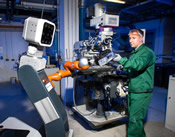Standardizing Collaborative Robots: What is ISO/TS 15066?
 Samuel Bouchard for Engineering.com: Collaborative robots (also known as cobots) are changing how robots and humans interact in our factories and manufacturing facilities.
Samuel Bouchard for Engineering.com: Collaborative robots (also known as cobots) are changing how robots and humans interact in our factories and manufacturing facilities.
No longer separated by cages, humans and cobots can work beside each other on complex tasks from picking and placement to assembly and logistics.
Human-cobot systems bring together the best of human capabilities (complex reasoning, ease of learning new tasks, pattern and object recognition in cluttered environments) and robot functionality (the ability to perform complex, tedious tasks 24/7 and with high precision).
The close proximity between humans and cobots and its advantages are exciting for manufacturers, SMEs, and the robotics industry, but it also brings a unique set of safety challenges.
Enter ISO/TS 15066 – the world's first specifications of safety requirements for collaborative robot applications. Cont'd...
Comments (0)
This post does not have any comments. Be the first to leave a comment below.
Featured Product

